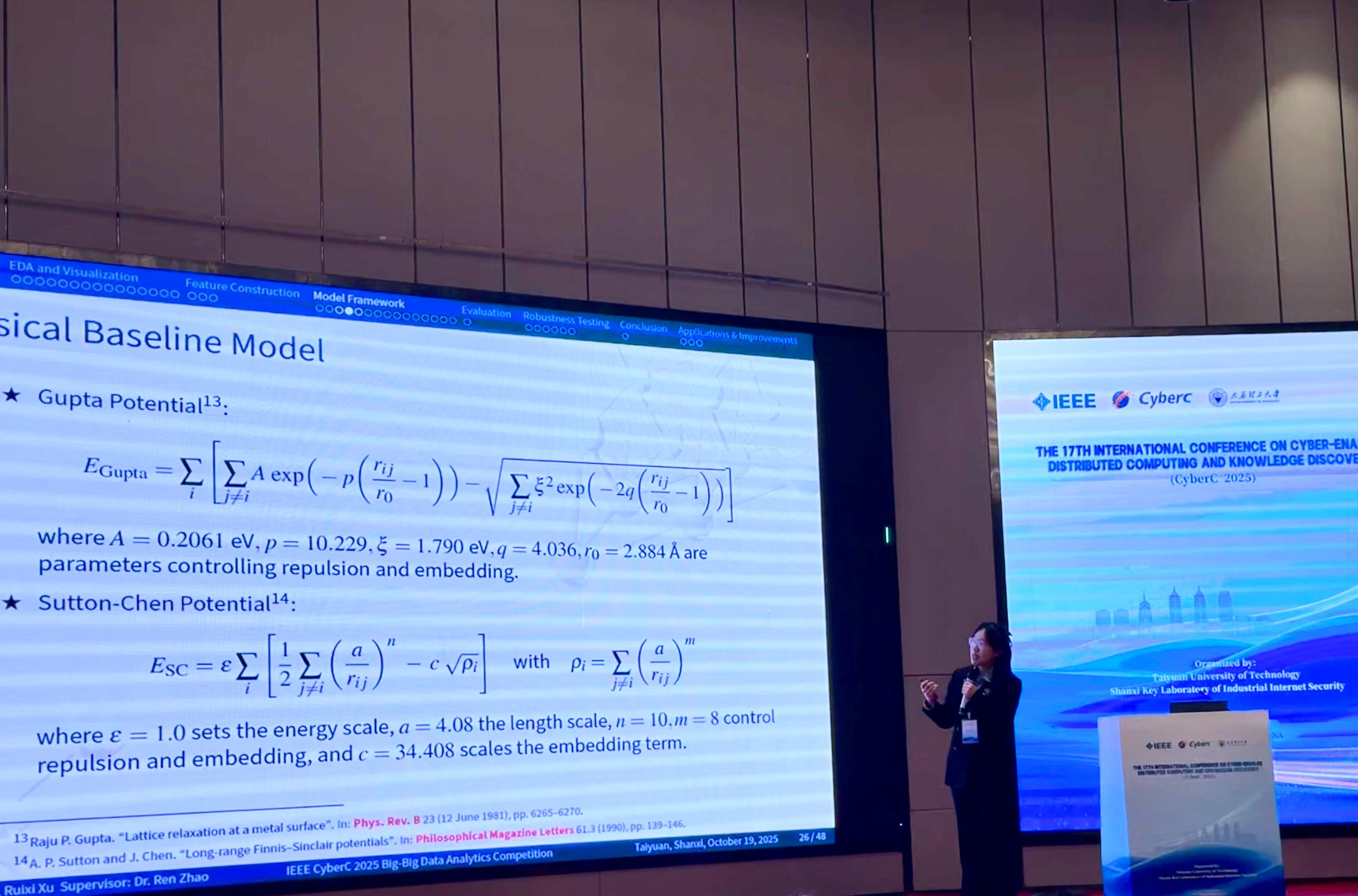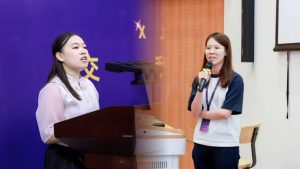10 Nov 2025
At the recently concluded IEEE TCBD CyberC International Big Data Challenge, undergraduate students Qimu Luo and Ruixi Xu from the International Business School Suzhou (IBSS) at Xi’an Jiaotong-Liverpool University (XJTLU), under the supervision of Dr Ren Zhao from the School of Mathematics and Physics, stood out among numerous participants and won second prize.

Jointly organised by IEEE TCCC and IEEE TCBD CyberC, this year’s competition focused on a practical problem in materials science: predicting the energy distribution of 999 different Au₂₀ (gold-20) cluster structures and identifying the most stable configurations.
Metal clusters are tiny aggregates of only a few atoms, serving as a crucial bridge between single atoms and bulk materials. The lower their energy, the more stable their structure, and the better their properties.
To illustrate this visually, imagine not studying an entire skyscraper, but the smallest, most intricate Lego blocks from which the skyscraper is built.
In conventional research, scientists use Density Functional Theory (DFT) for such calculations. Although highly accurate, DFT is computationally expensive and time-consuming. The competition encouraged participants to develop mathematical or machine learning-based models that could achieve comparable accuracy at a fraction of the computational cost.
“Don’t just look at the data - understand it first”
Under Dr. Zhao’s guidance, the students did not dive straight into complex equations. Instead, they began by getting to know their data.
“Many beginners treat data as a black box: they feed it into a model without really understanding how the model works, or how to interpret the output,” Dr Zhao explained.
Ruixi Xu and Qimu Luo broke through that limitation. Using Python and other tools, they carried out in-depth visualisation and structural analysis of the 999 gold clusters.
“I asked them to start by plotting typical cluster structures, so they could intuitively grasp geometric symmetry and rotational invariance,” said Dr Zhao. “Only when you truly understand the shapes and forms of your data can you know what kind of objects you are classifying and modelling.”
During this exploration, the students discovered fascinating patterns: some structures resembled utility poles, others badges, and some displayed clear axial symmetry. “These observations sparked their curiosity,” Dr Zhao added. “They realised that understanding data shapes is the very first step in effective modelling.”
 Visualisation, Graph Neural Networks, and AI-assisted Learning
Visualisation, Graph Neural Networks, and AI-assisted Learning
The team systematically visualised all 999 cluster structures in Python and even created dynamic rotating models, turning abstract atomic arrangements into vivid, intuitive images.
“Most teams presented static figures, but we used animations to show how the structures change in space, which made the patterns far clearer,” said Dr Zhao.

For the modelling stage, they adopted a Graph Neural Network (GNN) as the main framework, while also comparing various classical and self-designed approaches. They employed AI tools to support literature review and algorithm refinement.
“AI helped us quickly identify key methods in the field, but we were careful to verify every source and avoid hallucinations. We never relied on it blindly,” recalled Luo.
Xu added: “AI gave us inspiration, but ultimately, it was our own understanding and adjustment that made the model work.”
More than a Prize: A Journey of Growth
The team’s story began in Dr. Zhao’s Calculus class during their first year. Beyond being diligent learners, both students were deeply curious about how mathematics can be applied to real-world problems. This curiosity led them to join Dr Zhao’s SURF (Summer Undergraduate Research Fellowship) programme, where they spent two consecutive summers exploring advanced research topics, such as adaptive numerical methods based on neural networks and Transformer-based models for foreign exchange volatility prediction.
For Luo and Xu, this competition was just one milestone along their academic journey. They had previously achieved success in national and international contests such as the Citi Cup and the National Undergraduate Mathematical Modelling Competition, and had even published work in international journals.
According to Dr Zhao, project-based learning develops far more than technical research ability:
“Competitions are only vehicles, what matters most is that students genuinely develop independent thinking, teamwork and creative problem-solving skills in the process.”
A Competition Bridging Data and Science
The CyberC Big Data Challenge forms part of the annual IEEE CyberC Conference, which aims to bridge data science and real-world applications.

This year’s challenge attracted more than 30 teams worldwide and this team was among the few groups composed entirely of undergraduate students. Their success highlights how interdisciplinary curiosity, guided mentorship, and a research-oriented learning environment can together spark outstanding scientific innovation.
By Qinru Liu
Photos courtesy of Ren Zhao
10 Nov 2025







